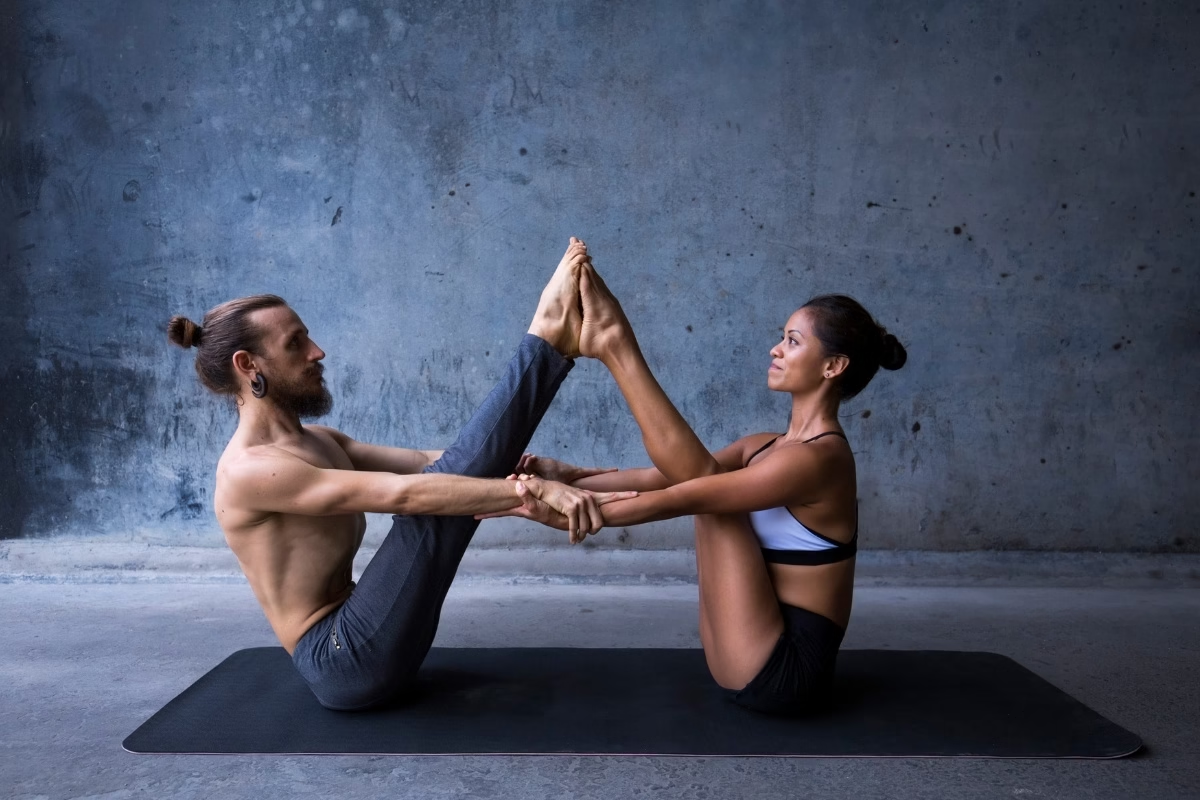Yoga is a deeply personal practice, but when done with a partner, it transforms into a shared journey of trust, communication, and connection.
Couple yoga poses, also called partner or 2-person yoga poses, go beyond the physical benefits of the practice. They create opportunities for couples to deepen their emotional bond, work together toward shared goals, and explore a playful side of yoga that is often overlooked.
As a yoga teacher, introducing couple yoga to your classes can elevate the experience for your students.
It adds a unique, interactive element that strengthens relationships while offering physical challenges and moments of lighthearted fun. Whether you’re running classes specifically for couples or adding partner yoga as a creative twist to your regular practice, these poses can foster connection and mutual growth.
This article highlights the best couple yoga poses to inspire trust and joy between partners, offering techniques to incorporate them into your sessions.
1. Partner Forward Fold
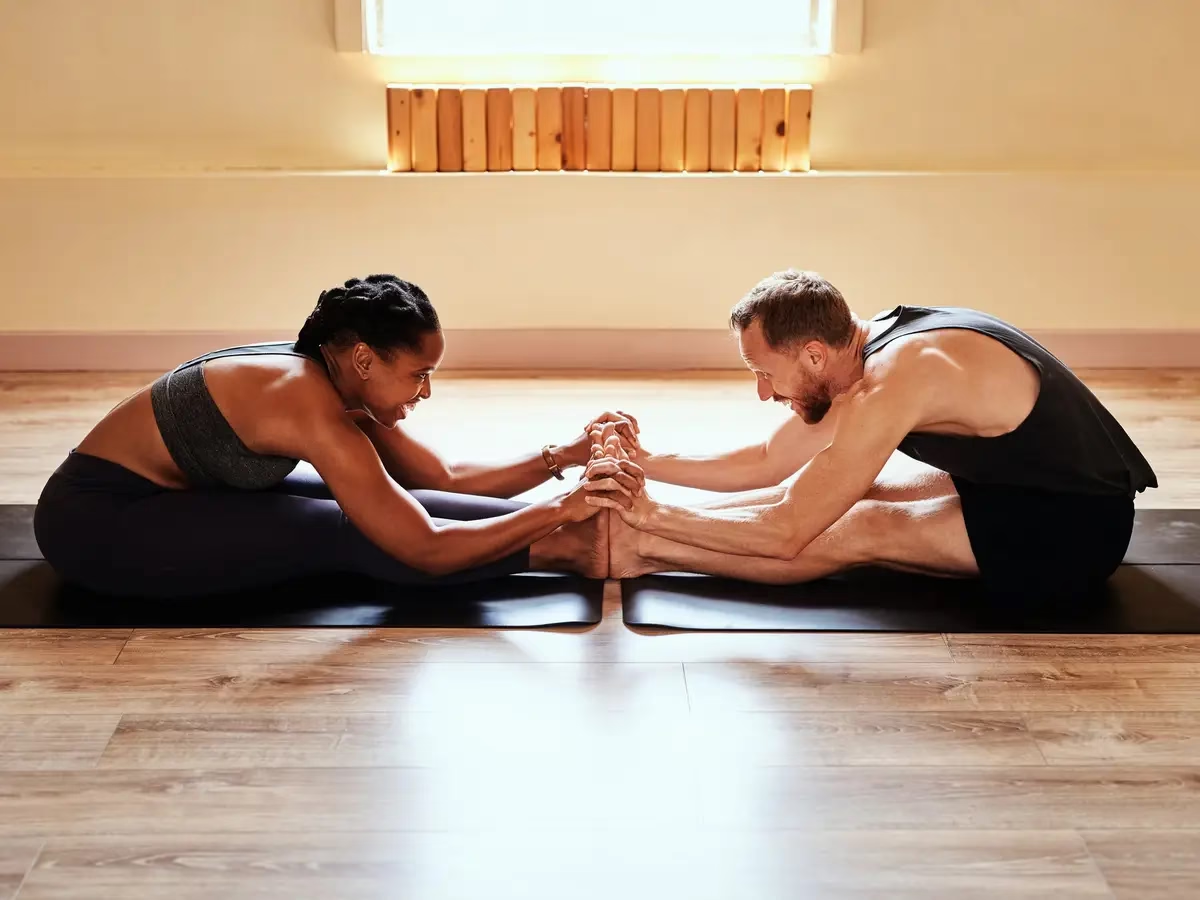
A grounding and gentle way to begin a couple’s yoga session, Partner Forward Fold creates a flow of energy and communication between the two participants. This pose combines a deep stretch with mutual support, making it ideal for warming up.
How to Do It:
- Partners sit facing each other with legs extended, their feet touching.
- They reach for each other’s wrists or hands.
- One partner gently leans back, allowing the other to fold forward into a stretch.
- Partners alternate, taking turns folding forward and leaning back.
Benefits:
- Physical Benefits: Encourages hamstring flexibility and improves posture.
- Emotional Connection: Builds trust as partners rely on each other for balance and support.
- Relaxation: The gentle stretch helps release tension while creating a flow of energy between partners.
Encourage partners to communicate about how far they want to stretch, ensuring comfort and a sense of safety throughout the pose.
2. Twin Tree Pose

Tree Pose is a classic yoga posture that fosters balance and grounding. When performed as a couple, it evolves into a collaborative practice of mutual stability and connection.
How to Do It:
- Partners stand side by side, facing the same direction, with their inner arms wrapped around each other’s waists.
- Each partner lifts their outer foot and places it on the inner thigh or calf of their standing leg.
- Together, they raise their outer arms overhead, bringing their palms to touch or forming a heart shape.
Benefits:
- Improved Balance: Partners learn to adjust and synchronize their movements to maintain stability.
- Trust Building: Relying on each other for support fosters a deeper sense of connection.
- Playfulness: The pose encourages lightheartedness as partners work together to stay upright.
This pose is perfect for cultivating teamwork, as students must tune into each other’s movements to find balance.
3. Seated Spinal Twist
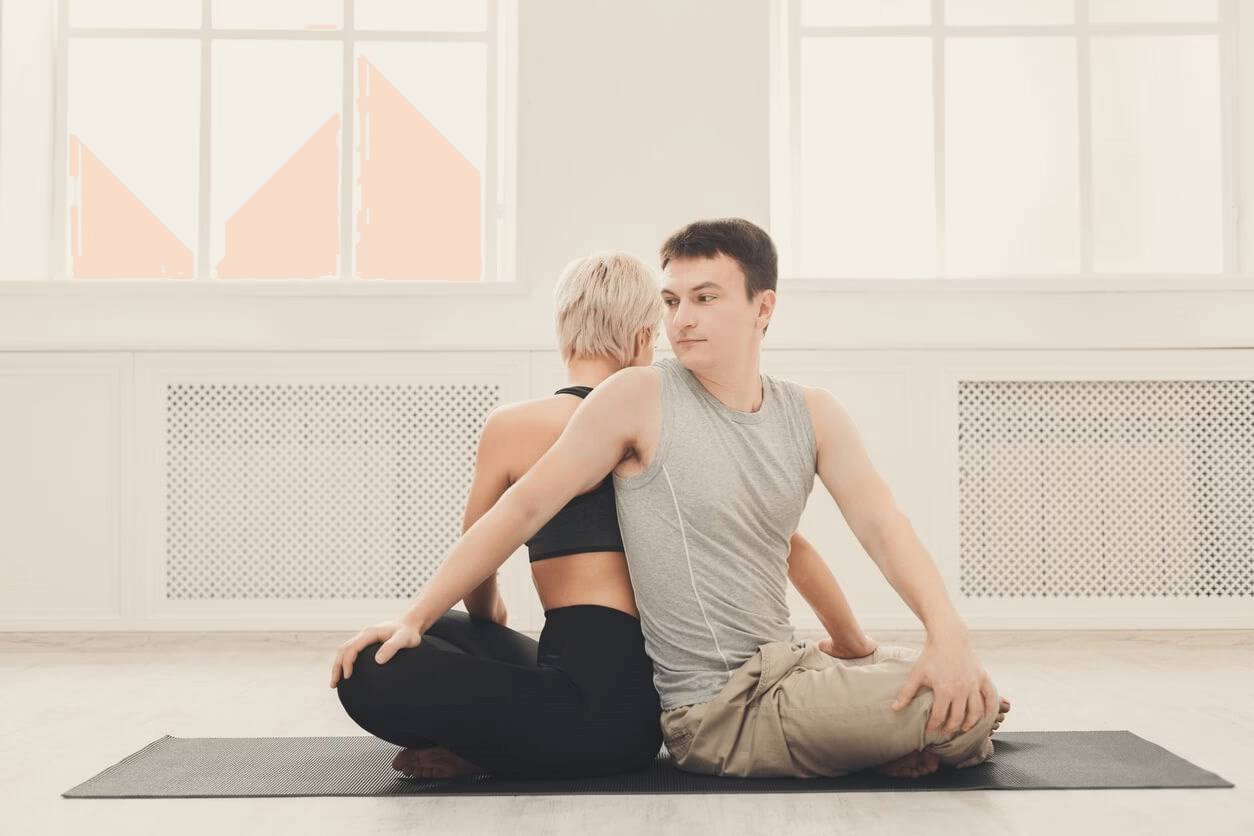
A partner variation of the classic spinal twist, this pose encourages alignment and breath synchronization while fostering a sense of unity.
How to Do It:
- Partners sit back-to-back with their legs crossed in a comfortable seated position.
- Each partner places their right hand on the other’s left knee and their left hand on their own right knee.
- They twist gently to the right, using each other’s support to deepen the stretch.
- On an inhale, they lengthen their spines; on an exhale, they twist further into the pose.
Benefits:
- Spinal Mobility: Improves flexibility and posture through gentle twisting.
- Shared Breathwork: Synchronizing breath enhances mindfulness and connection.
- Unity: The back-to-back position creates a physical sense of alignment and support.
This pose reminds couples to move mindfully together, emphasizing mutual respect and presence.
4. Double Downward Dog
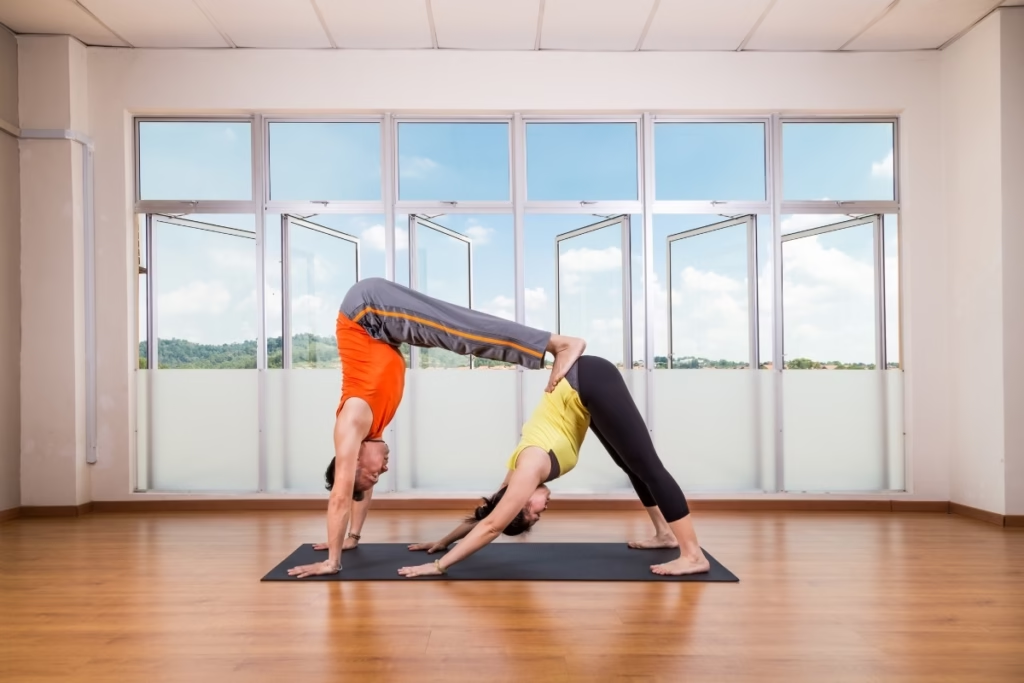
A playful and slightly challenging pose, Double Downward Dog combines trust, balance, and physical strength. This pose is particularly rewarding for partners who enjoy experimenting with creative postures.
How to Do It:
- One partner begins in a traditional Downward Dog position, creating a strong and stable foundation.
- The second partner stands at the first partner’s feet, places their hands on the mat, and carefully steps their feet onto the lower back or hips of the partner in Downward Dog.
- Both partners hold the pose for a few breaths before switching roles.
Benefits:
- Physical Strength: Builds core, arm, and shoulder strength for both partners.
- Trust: Encourages the base partner to provide support and the top partner to let go of fear.
- Connection: Promotes teamwork as partners adjust to find balance together.
Remind students to communicate clearly during this pose to ensure safety and comfort.
5. Flying Warrior (Acro Yoga)
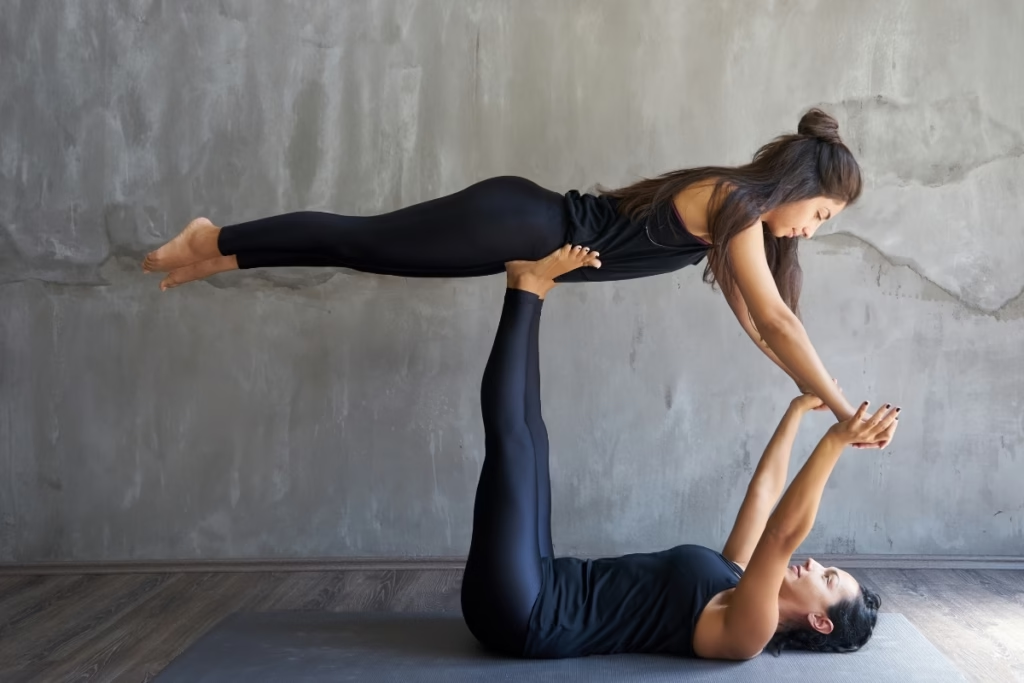
Flying Warrior is a stunning and rewarding pose that combines elements of Acro Yoga with the power of trust and collaboration. It’s an exciting challenge for partners who want to explore their limits while building strength and coordination.
How to Do It:
- The base partner lies flat on their back with knees bent and feet on the mat.
- The flyer stands at the base’s feet, allowing the base to place their feet on the flyer’s hips or pelvis.
- Once balanced, the flyer extends their arms and legs into a Warrior pose, maintaining alignment and strength.
- The base partner holds the flyer’s hands or wrists for additional stability.
Benefits:
- Strength and Stability: Both partners engage their core muscles to maintain balance.
- Trust and Communication: Requires clear communication and confidence in each other’s abilities.
- Joyful Energy: The dynamic nature of the pose creates excitement and a sense of accomplishment.
Flying Warrior embodies the essence of couple yoga: shared effort, trust, and playful energy.
How Couple Yoga Poses Strengthen Relationships
Practicing couple yoga poses does more than stretch muscles and improve strength—it strengthens relationships in profound ways.
- Trust Building: Many 2-person yoga poses require one partner to fully support the other, fostering mutual trust.
- Enhanced Communication: Partners must communicate effectively to achieve balance and alignment, improving how they work together both on and off the mat.
- Mindful Presence: Moving and breathing together encourages couples to stay present, appreciating the moment they’re sharing.
- Playfulness: Laughter and lightheartedness often emerge in couple yoga, making the experience fun and memorable.
For a well-rounded practice, consider incorporating other calming styles like yin yoga poses or restorative yoga poses into your sessions. These approaches offer a slower pace, encouraging relaxation and mindfulness that beautifully complement the playful energy of couple yoga.
Final Thoughts: Building Bonds Through Yoga
Couple yoga poses bring a playful and trust-building element to your classes, transforming them into unforgettable experiences. By encouraging partners to work together, support each other, and embrace the joy of movement, you foster connections that extend beyond the mat.
Whether you’re teaching poses that enhance flexibility, build strength, or inspire laughter, couple yoga is a powerful way to nurture relationships while adding energy and creativity to your sessions.
Ready to bring the magic of couple yoga to your classes?
Elevate your classes with our free Yoga Deck, perfect for designing sequences that challenge and inspire. Pair it with insights from the rest of the articles in our Journal to take your advanced teaching to the next level. Whether you’re working with beginners, focusing on yoga basics, or challenging students with advanced poses, our guides offer valuable tips to enhance your classes.

